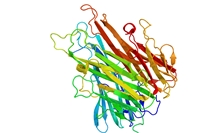In the same section
- Accueil
- EN
- Research
- Research projects
- Fédération Wallonie-Bruxelles
- "Actions de recherche concertées" (ARC)
-
Share this page
Research project "High density protein microarrays" (ARC program)
Design of high density protein microarrays for ligand binding detection by FTIR imaging

Proteins are not only involved in a very large number of biological processes but are also more and more widely used in the field of health, nanotechnologies and medicine. In turn, there is an urgent need to develop approaches for fast identification and structural characterization of a large panel of proteins and their selective identification in complex media and ideally in vivo.
The first part of the project aims at building high density biosensors able to monitor quickly the presence of a large variety of proteins in a solution. A new approach based on FTIR imaging will detect binding of proteins on high density microarrays of receptors (e.g. hundreds of specific antibodies) in a single measurement. Full FTIR spectra will be obtained for each species, bringing information on protein identity, post-translational modifications and conformation. In a second step, for selected proteins of interest, liquid phase detection will be developed by the exploitation of the unique emission and absorption properties of nanomaterials. The elaboration of the various biosensors will rely on an original surface functionalization strategy based on covalent grafting of calixarene-tetradiazoniums.
Principal investigators: E. Goormaghtigh et V. Raussens - Structure et Fonctions des Membranes Biologiques -, I. Jabin - Service de Chimie et PhysicoChimie Organiques -, Gilles Bruylants - Ingénierie des NanoSystèmes Moléculaires -.
Spokesperson
Erik Goormaghtigh
Structure and Function of Biological Membranes
Faculty of Sciences
